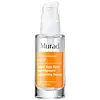What's inside
What's inside
 Key Ingredients
Key Ingredients

 Benefits
Benefits

 Concerns
Concerns

 Ingredients Side-by-side
Ingredients Side-by-side

Water
Skin ConditioningCyclopentasiloxane
EmollientDimethicone
EmollientPolysilicone-11
Isododecane
EmollientButylene Glycol
HumectantAscorbyl Glucoside
AntioxidantPEG-10 Dimethicone
Skin ConditioningPEG-6
HumectantMorus Bombycis Root Extract
Skin ConditioningScutellaria Baicalensis Root Extract
AstringentCamellia Sinensis Leaf Extract
AntimicrobialCucumis Sativus Fruit Extract
EmollientSaccharomyces Lysate Extract
HumectantHordeum Vulgare Extract
EmollientSalicylic Acid
MaskingTriticum Vulgare Germ Extract
Skin ConditioningCholesterol
EmollientOryza Sativa Bran Extract
Skin ConditioningSqualane
EmollientAcetyl Glucosamine
Skin ConditioningSodium Hyaluronate
HumectantCaffeine
Skin ConditioningIsohexadecane
EmollientBetula Alba Bark Extract
MaskingTrametes Versicolor Extract
Sodium Rna
Skin ConditioningGlycyrrhetinic Acid
Skin ConditioningDimethoxytolyl Propylresorcinol
AntioxidantDi-C12-18 Alkyl Dimonium Chloride
Skin ConditioningHelianthus Annuus Seedcake
AbrasiveYeast Extract
Skin ConditioningCaprylyl Glycol
EmollientPropylene Glycol Dicaprate
EmollientAmmonium Acryloyldimethyltaurate/Vp Copolymer
Acrylamide/Sodium Acryloyldimethyltaurate Copolymer
Emulsion StabilisingPolysorbate 20
EmulsifyingTocopheryl Acetate
AntioxidantPolysorbate 80
EmulsifyingTromethamine
BufferingSodium Hydroxide
BufferingHexylene Glycol
EmulsifyingDisodium EDTA
Sodium Benzoate
MaskingSodium Metabisulfite
AntioxidantSodium Sulfite
PreservativePhenoxyethanol
PreservativeCI 15985
Cosmetic ColorantCI 19140
Cosmetic ColorantWater, Cyclopentasiloxane, Dimethicone, Polysilicone-11, Isododecane, Butylene Glycol, Ascorbyl Glucoside, PEG-10 Dimethicone, PEG-6, Morus Bombycis Root Extract, Scutellaria Baicalensis Root Extract, Camellia Sinensis Leaf Extract, Cucumis Sativus Fruit Extract, Saccharomyces Lysate Extract, Hordeum Vulgare Extract, Salicylic Acid, Triticum Vulgare Germ Extract, Cholesterol, Oryza Sativa Bran Extract, Squalane, Acetyl Glucosamine, Sodium Hyaluronate, Caffeine, Isohexadecane, Betula Alba Bark Extract, Trametes Versicolor Extract, Sodium Rna, Glycyrrhetinic Acid, Dimethoxytolyl Propylresorcinol, Di-C12-18 Alkyl Dimonium Chloride, Helianthus Annuus Seedcake, Yeast Extract, Caprylyl Glycol, Propylene Glycol Dicaprate, Ammonium Acryloyldimethyltaurate/Vp Copolymer, Acrylamide/Sodium Acryloyldimethyltaurate Copolymer, Polysorbate 20, Tocopheryl Acetate, Polysorbate 80, Tromethamine, Sodium Hydroxide, Hexylene Glycol, Disodium EDTA, Sodium Benzoate, Sodium Metabisulfite, Sodium Sulfite, Phenoxyethanol, CI 15985, CI 19140
Water
Skin ConditioningAlcohol Denat.
AntimicrobialGlycolic Acid
BufferingButylene Glycol
HumectantGlycerin
HumectantMethyl Gluceth-10
EmulsifyingDextran
Hexapeptide-2
BleachingRice Amino Acids
Skin ConditioningAloe Barbadensis Leaf Juice
Skin ConditioningUrea
BufferingYeast Amino Acids
HumectantTrehalose
HumectantInositol
HumectantTaurine
BufferingBetaine
HumectantZinc Gluconate
Skin ConditioningAscorbic Acid
AntioxidantChitosan
Propyl Gallate
AntioxidantNonyl Nonoxynol-10
Lecithin
EmollientTocopherol
AntioxidantMagnesium Ascorbyl Phosphate
AntioxidantDipotassium Glycyrrhizate
HumectantPalmitoyl Hydroxypropyltrimonium Amylopectin/Glycerin Crosspolymer
Skin ConditioningVitis Vinifera Seed Extract
AntimicrobialChitosan PCA
HumectantAllantoin
Skin ConditioningPolyquaternium-10
Sodium Metabisulfite
AntioxidantSodium Sulfite
PreservativeSodium Hydroxide
BufferingPPG-26-Buteth-26
Skin ConditioningPEG-40 Hydrogenated Castor Oil
EmulsifyingHydroxyethylcellulose
Emulsion StabilisingDisodium EDTA
Limonene
PerfumingLinalool
PerfumingParfum
MaskingWater, Alcohol Denat., Glycolic Acid, Butylene Glycol, Glycerin, Methyl Gluceth-10, Dextran, Hexapeptide-2, Rice Amino Acids, Aloe Barbadensis Leaf Juice, Urea, Yeast Amino Acids, Trehalose, Inositol, Taurine, Betaine, Zinc Gluconate, Ascorbic Acid, Chitosan, Propyl Gallate, Nonyl Nonoxynol-10, Lecithin, Tocopherol, Magnesium Ascorbyl Phosphate, Dipotassium Glycyrrhizate, Palmitoyl Hydroxypropyltrimonium Amylopectin/Glycerin Crosspolymer, Vitis Vinifera Seed Extract, Chitosan PCA, Allantoin, Polyquaternium-10, Sodium Metabisulfite, Sodium Sulfite, Sodium Hydroxide, PPG-26-Buteth-26, PEG-40 Hydrogenated Castor Oil, Hydroxyethylcellulose, Disodium EDTA, Limonene, Linalool, Parfum
 Reviews
Reviews

Ingredients Explained
These ingredients are found in both products.
Ingredients higher up in an ingredient list are typically present in a larger amount.
Butylene Glycol (or BG) is used within cosmetic products for a few different reasons:
Overall, Butylene Glycol is a safe and well-rounded ingredient that works well with other ingredients.
Though this ingredient works well with most skin types, some people with sensitive skin may experience a reaction such as allergic rashes, closed comedones, or itchiness.
Learn more about Butylene GlycolDisodium EDTA plays a role in making products more stable by aiding other preservatives.
It is a chelating agent, meaning it neutralizes metal ions that may be found in a product.
Disodium EDTA is a salt of edetic acid and is found to be safe in cosmetic ingredients.
Learn more about Disodium EDTASodium Hydroxide is also known as lye or caustic soda. It is used to adjust the pH of products; many ingredients require a specific pH to be effective.
In small amounts, sodium hydroxide is considered safe to use. However, large amounts may cause chemical burns due to its high alkaline.
Your skin has a natural pH and acid mantle. This acid mantle helps prevent harmful bacteria from breaking through. The acid mantle also helps keep your skin hydrated.
"Alkaline" refers to a high pH level. A low pH level would be considered acidic.
Learn more about Sodium HydroxideSodium metabisulfite is also known as Sodium Pyrosulfite. It is a preservative, antioxidant, and disinfectant.
As a preservative, it helps stabilize cosmetic formulas without affecting their color or scent.
Sodium Sulfite is a preservative. Preservatives help prevent mold and bacteria from growing in cosmetics.
This ingredient has been shown to break the bonds in hair, acting as a natural straightener.
It is commonly used in food. It should be noted sodium sulfite degrades both vitamins B1 and E.
Fun fact: Sulfites are naturally occuring in wine.
Learn more about Sodium SulfiteWater. It's the most common cosmetic ingredient of all. You'll usually see it at the top of ingredient lists, meaning that it makes up the largest part of the product.
So why is it so popular? Water most often acts as a solvent - this means that it helps dissolve other ingredients into the formulation.
You'll also recognize water as that liquid we all need to stay alive. If you see this, drink a glass of water. Stay hydrated!
Learn more about Water